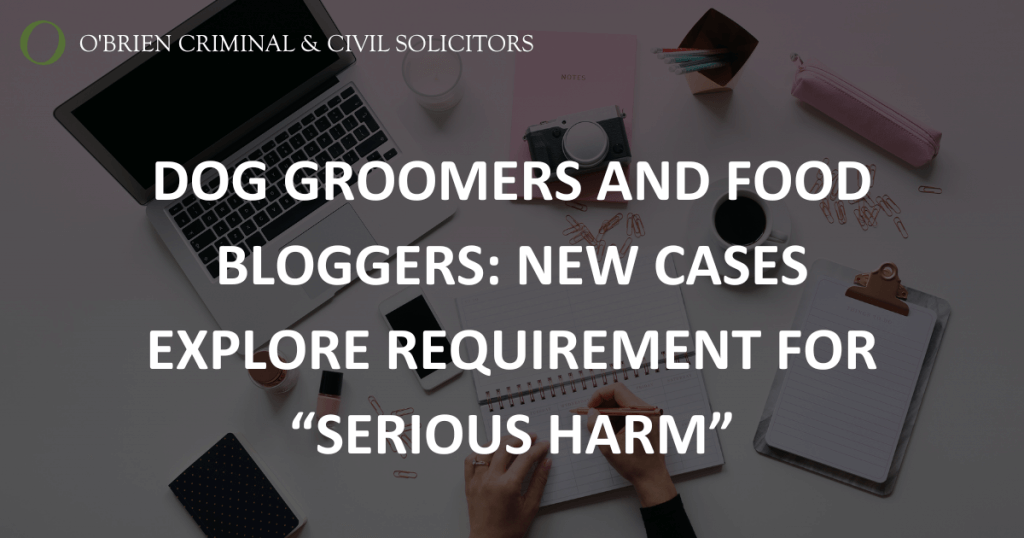In the last week, two decisions handed down the NSW District Court carefully examined the new requirements for “serious harm” in defamation cases.
On 1 July 2021, the Defamation Act 2005 (NSW) (“the Act”) enacted new provisions which created a requirement for the plaintiff to prove serious harm.
Section 10A, an adaptation from section 1 of the Defamation Act 2013 (UK), was a reform to discourage the bringing of cases likely to result in modest damages awards. The problem here being that the costs were out of proportion to the damages.
Preliminary hearing of serious harm
If a plaintiff cannot establish serious harm, that is the end of the proceedings.
Under section 10A(5) of the Act, a party may apple for the serious harm element to be determined as soon as practicable.
“If a party applies for the serious harm element to be determined before the trial for the proceedings commences, the judicial officer is to determine the issue as soon as practicable before the trial commences unless satisfied that there are special circumstances justifying the postponement of the determination to a later stage of the proceedings (including during the trial).”
Zimmerman v Perkiss [2022] NSWDC 448 handed down on 7 October was the first case in Australia to make a preliminary determination about serious harm prior to continuation of proceedings.
Causation between publication and serious harm must be drawn
In Martin v Najem [2022] NSWDC 479, Her Honour referred to the case of Rader v Haines [2021] NSWDC 610 in which her own decision was upheld by the NSW Supreme Court.
Her Honour noted that the Martin was the first to address serious harm under the Australian laws, as Radar was based on the UK Defamation Act.
The Plaintiff in Martin submitted the relevant factors relevant to serious harm were:
- The meaning of the words and the gravity of any imputations.
- The extent of publication.
- The standing of the defendant.
- The identity of the recipients and their relationship (if any) with the plaintiff.
- The circumstances of the plaintiff.
- The reaction of the recipients.
Her Honour noted however these were headings, rather than evidence.
“Fact-rich proof of harm” required, Court confirms
The Court held that serious harm requires actual fact-rich proof of harm which is actually, or likely, to be serious – rather than inferences of serious harm.
“There must be causation between the publications and the serious harm”, Her Honour stated in Martin.
“’Serious harm’ may be established by inference, particularly in relation to future matters, such as whether the statement was read by people who will come to know him in the future”
Her Honour held the following considerations were applicable to determine whether serious harm was met by Martin:
a. The publications were unique in that there were threats of serious physical and professional harm. The imputations were “in the context of the defendant asserting that the plaintiff deserves to be harmed because of the asserted truth of their contents and he calls on his followers to do so”;
b. The extreme nature of the allegations, which Her Honour noted was an important factor. “There are few more hated criminals in Australia than paedophiles. They are not even safe in gaol.”
c. The manner of the publication is key. “The defendant is making a call to arms to his supporters”.
d. The extent of publication is wide. While Najem failed to provide analytics in relation to the matters, the Court acknowledged that the followers alone, in the tens of thousands, coupled with the AI technology of social media distributing it to non-followers feeds, resulted in substantial audience.
e. Najem utilised two accounts in order to get past Instagram’s abuse policies. He used the accounts in a joint effort which is important to note in relation to importance of audience size, the court said.
f. There was factual evidence that there was an extensive grapevine effect. This was proven by the comments posted by third parties, and the affidavit of Mr Nesbitt, the person who first alerted the Plaintiff to the posts.
g. The actual damage done to the Plaintiff in relation to his health, and concerns about security.
The court notes the harm is exacerbated by the continued publication from the defendant and continued threatening messages from third parties.
Harm to the Plaintiff’s health and security is an aspect of Serious Harm
While hurt to feelings is irrelevant to serious harm according to Radar, evidence of harm to the Plaintiff’s health and security can be a factor in establishing serious harm.
In Rader v Haines, Her Honour at the preliminary trial held at [125] that “Serious harm should not be conflated with hurt to feelings. However distraught the plaintiff may have been, this personal hurt is not evidence of harm to reputation because harm depends upon ‘a combination of the inherent tendency of the words and their actual impact on those to whom they were communicated’” This was upheld by the Court of Appeal.
However, in Martin, Her Honour held that tangible evidence of impact to health can be considered in assessing serious harm.
“The impact on [the Plaintiff’s] health is serious and capable of itself to amount to serious harm,” she stated.
This serious impact included the Plaintiff stating that:
- Suffered stress and anxiety;
- Sought medical attention and had to take medication;
- Remained away from suburbs with high-muslim population for fear of being recognised;
- Remains concerns about dangers to himself, his wife and children;
- Remains concerned about the impact of the allegations on his business;
- Is worried that Muslim people won’t want to deal with him, in particular Lebanese-Australian Muslims.
It’s important to note the Plaintiff’s evidence was not cross-examined as the Defendant did not appear at the hearing.
No serious harm to dog groomer, Court states
In Zimmerman, the Defendant sent multiple messages on Facebook to one person only. That person was the Plaintiff’s new employer.
The messages sent over 30 minutes stated:
- Hey
- Good luck
- Katie resigned due to organising the theft of company possessions.
- You should check references.
- She went on stress leave due to not coping with being caught taking items from the business
- We could have had police involved
- About $1000 worth of scissors taken.
- she denied all
- 8 cameras don’t lie.
Concerns notice attempts to define the harm
The Plaintiff submitted in the Concerns Notice that the serious harm was:
a. Financial loss resulting from difficulty procuring alternate employment (which may be ongoing).
b. Purchase of equipment of new employment (presumably dog scissors, although this was never explained).
c. Humiliation and damage to reputation within the dog grooming industry and from future employers.
Her Honour stated that these particulars were repeated in the amended statement of claim, however “shrunk away to nothing”.
“All the plaintiff was left with was her new claim of damage to reputation in the eyes of her current employer which was an enlargement of the reference to her current employer’s ‘adverse’ and ‘strong’ reaction in the amended statement of claim.”
Her Honour held that was insufficient to prove serious harm.
“At its highest, the plaintiff’s claim cannot identify to any other source of serious harm beyond what is asserted to be a change in attitude towards her by her employer for a few weeks, a claim which I have not accepted. I do not consider that the plaintiff’s reputation suffered any harm in Ms McPherson’s eyes at all.”
Court clarifies Plaintiffs aren’t wedded to serious harm pleaded in Concerns Notice
The court noted that the plaintiff was not confined to the particulars outlined in the Concerns Notice.
“s 12A(1)(a)(iv) only requires her to set out the harm that she “considers” to be serious, and not harm which is objectively determinable as serious. However, while the plaintiff is entitled to amend and replead her particulars of serious harm, past and/or future, a series of attempts of the kind demonstrated here may suggest that in fact no harm, serious or otherwise, has in fact occurred or was likely to occur. This was one of the submissions made by the defendant.”
In Martin, Her Honour held that the Court can also infer its own considerations of serious harm when generic headings are used in the Concerns Notice.
In relation to the Defendant’s “call to arms”, Her Honour noted that “there is a reference to the manner of publication in the concerns notice and have treated this as a form of particular of serious harm, which the concerns notice has not specifically spelled out. References such as these, however, would be capable of amounting to serious harm, whether specified as such in the concerns notice or not.”
Practical guidance for Serious Harm
While serious harm must be outlined in the Concerns Notice under s12A, the Court confirmed that the Plaintiff is not confined to the explicit particularisation of serious harm in the notice.
Zimmerman explains that publication to one person, where that person states the Plaintiff’s reputation is undamaged, without anything further, is not sufficient to meet the requirements of serious harm.
Martin outlines what the Court deemed as sufficient for the purposes of serious harm.
If Plaintiff’s are looking to take action for defamation, it’s important to carefully analyse the serious harm elements and whether they would be sufficient to meet the requirements set by this Court.
If you need to seek injunctions or believe your reputation has been harmed over social media, contact our defamation lawyers today. The first consultation is free.
Sarah is a civil solicitor who primarily practices in defamation, intentional torts against police, privacy and harassment.
- Sarah Gorehttps://obriensolicitors.com.au/author/sarahg/
- Sarah Gorehttps://obriensolicitors.com.au/author/sarahg/
- Sarah Gorehttps://obriensolicitors.com.au/author/sarahg/
- Sarah Gorehttps://obriensolicitors.com.au/author/sarahg/





